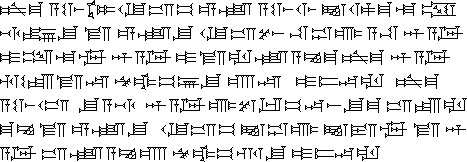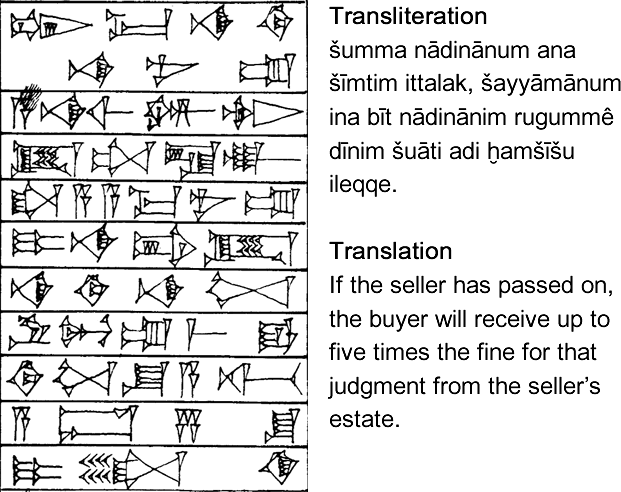Akkadian was a Semitic language spoken in Mesopotamia (modern Iraq and Syria) between about 2,800 BC and 500 AD. It was named after the city of Akkad and first appeared in Sumerian texts dating from 2,800 BC in the form of Akkadian names.
The Akkadian cuneiform script was adapted from Sumerian cuneiform in about 2,350 BC. At the same time, many Sumerian words were borrowed into Akkadian, and Sumerian logograms were given both Sumerian and Akkadian readings. In many ways the process of adapting the Sumerian script to the Akkadian language resembles the way the Chinese script was adapted to write Japanese. Akkadian, like Japanese, was polysyllabic and used a range of inflections while Sumerian, like Chinese, had few inflections.
A large corpus of Akkadian texts and text fragments numbering hundreds of thousands has been excavated. They include mythology, legal and scientific texts, correspondence and so on. During the 2nd millenium BC, the Akkadian language developed into two variants, Assyrian and Babylonian, in Assyria and Babylon.
Akkadian became the lingua franca of the ancient Near East, but started to be replaced by Aramaic by the 8th century BC. After that it continued to be used mainly by scholars and priests and the last known example of written Akkadian dates from the 1st century AD.


ni-šu-ka-lu-ši-na-e-la-tum-wa-al-da-ma-i-na-a-wi-lu-tim-u-ma-ṣi-a-li-ba-u-mil-ka-am-i-ša-ma-mit-ḫa-ri-iš-i-na-a-ḫu-tim-i-pe-ša
All human beings are born free and equal in dignity and rights. They are endowed with reason and conscience and should act towards one another in a spirit of brotherhood.

Source: https://ehammurabi.org/
Information about the Akkadian language and writing system:
http://www.sron.nl/~jheise/akkadian
http://en.wikipedia.org/wiki/Akkadian_language
http://en.wikipedia.org/wiki/Assyrian_cuneiform#Akkadian_cuneiform
http://history-world.org/akkadians.htm
Akkadian Dictionary
http://www.premiumwanadoo.com/cuneiform.languages/dictionary/index_en.php
Sources of Early Akkadian Literature - a Text Corpus of Babylonian and Assyrian Literary Texts from the 3rd and 2nd Millennia BC: http://www.seal.uni-leipzig.de/
Free Akkadian fonts
http://space.tin.it/clubnet/bxpoma/akkadeng/cf_fonts.htm
Akkadian, Amharic, Arabic (Algerian), Arabic (Bedawi), Arabic (Chadian), Arabic (Egyptian), Arabic (Gulf), Arabic (Hassaniya), Arabic (Hejazi), Arabic (Lebanese), Arabic (Modern Standard), Arabic (Moroccan), Arabic (Najdi), Arabic (Sudanese), Arabic (Syrian), Aramaic, Argobba, Assyrian / Neo-Assyrian, Canaanite, Chaha, Chaldean Neo-Aramaic, Ge'ez, Hadhramautic, Harari, Hebrew, Himyaritic, Jewish Neo-Aramaic, Maltese, Mandaic, Nabataean, Neo-Mandaic, Phoenician, Punic, Qatabanic, Sabaean, Sabaic, Silt'e, Syriac, Tigre, Tigrinya, Turoyo, Ugaritic, Western Neo-Aramaic
Akkadian, Elamite, Hittite, Old Persian Cuneiform, Sumerian, Ugaritic
Akkadian Cuneiform, Ancient Egyptian (Demotic), Ancient Egyptian (Hieratic), Ancient Egyptian (Hieroglyphs), Chinese, Chữ-nôm, Cuneiform, Japanese, Jurchen, Khitan, Linear B, Luwian, Mayan, Naxi, Sawndip (Old Zhuang), Sui, Sumerian Cuneiform, Tangut (Hsihsia)
Page last modified: 15.01.25
[top]
You can support this site by Buying Me A Coffee, and if you like what you see on this page, you can use the buttons below to share it with people you know.

If you like this site and find it useful, you can support it by making a donation via PayPal or Patreon, or by contributing in other ways. Omniglot is how I make my living.
Note: all links on this site to Amazon.com, Amazon.co.uk
and Amazon.fr
are affiliate links. This means I earn a commission if you click on any of them and buy something. So by clicking on these links you can help to support this site.
[top]